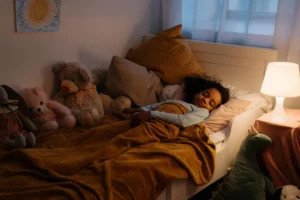Getting small children to sleep independently can be a real challenge for many parents. We, know, as expert sleep coaches we have each been there with our own children, and now it is regular focus for our clients. Introducing good sleep habits early on is crucial for a child’s development, and it can utterly transform parent’s peace of mind and how the rest of the family sleep too. Not surprisingly, helping to teach a child independence and self-soothing skills plays a key role in successful sleep training.

So why is teaching sleeping independently so important?
Sleep Disruptions – Children who struggle to fall asleep on their own often experience more frequent night wakings. This can result in disrupted sleep patterns, leading to fatigue and irritability during the day. Soon a cycle of poor sleep can unfold.
Increased Dependence on Parents – Children not encouraged to sleep independently can become overly reliant on their parents input for comfort and assistance at bedtime and during the night. This can lead to difficulties in managing their nighttime routines as they grow older.
Difficulty with Transitions – Without learning to self-soothe and sleep independently, children can struggle with transitions, such as moving from a crib to a bed. This can lead to anxiety around bedtime and a reluctance to sleep alone.
Impact on Parental Well-Being – Parents may find themselves exhausted from constantly attending to their child’s sleep needs. This can lead to increased stress and a lack of personal time, impacting a parent’s overall well-being, family dynamics and even their ability to work.
Tip to help your little ones learn to sleep independently:
- Establish a Consistent Bedtime Routine
Creating a calming bedtime routine will help your child learn that it’s time to wind down and prepare for sleep. These routines can differ between families based on lifestyle needs such as fitting in with nursery times, or when parents return from work, but keeping them as consistent as possible is important. Activities could include a bath after dinner, reading a story, having a baby massage, listening to soft music. Consistency is key and it’s all about calm wind-down time.

- Create a Comfortable Sleep Environment
Ensure your child’s sleeping environment is calm and conducive to rest. Ensure a comfortable mattress, appropriate bedding, and a dark, quiet room. Consider using white noise machines (we love the Shushiie) and blackout curtains to help create an ideal sleeping atmosphere. Avoid mobiles in the crib, projectors with lights, or anything that could stimulate your little one and keep it cool, usually between 16-20 Celsius/62-68 degrees Fahrenheit. Combat the room temperature with an age-appropriate sleeping bag (we love Tickle Tickle) instead of loose bedding for children under 4 years old. The Lullaby Trust website offers lots of great advice for safe sleep.

- Encourage Self-Soothing Techniques
Teach your child self-soothing techniques to help them manage their emotions when they wake up at night. The goal is to empower them to return to sleep without relying on parental intervention. This doesn’t mean ‘cry it out’ but expect your little one to communicate dissatisfaction for a little time! It is important to decide which route to take to reduce involvement and help them learn self-soothing.
- What can self-soothing look like?
Signs of self-soothing can vary but commonly you will see actions like sucking on fingers, head rolling from side to side, holding hands, rubbing eyes and stroking their nose. It can also include repositioning or rolling around in the crib or small bed, before falling asleep, or crying in a fussy way, with a pause. Older children may self-soothe by rocking, sucking on clothing or toys, twirling hair, or mumbling self-talk.
- Gradual Transition to Independent Sleep
If your child is accustomed to falling asleep in your presence, approach this change with a gradual transition. Start by sitting in the room until they fall asleep, then slowly move further away each night until they can drift off on their own. This method can help ease the anxiety of separation, for both parties. Avoid rushing in and to pick them up, if they immediately request it. You can soothe just by being present, verbally shooshing and maybe a hair stroke, or pat. Gradually limiting external support each time.
- Be Patient and Consistent
Learning to sleep independently takes time, and every child is different. Be patient and consistent with your approach. Avoid giving in to demands for extra attention during the night, as this can reinforce dependency, create lengthy night wakings and undo good work achieved so far. Instead, offer reassurance and if old enough, remind them of their progress.

Conclusion
Helping small children learn to sleep independently requires patience, consistency and sometimes outside support from a sleep coach. But, by establishing a routine, creating a comfortable environment, and encouraging self-soothing, you can support your child in developing these essential skills. Remember, the goal is not just to get them to sleep alone, but to encourage a sense of security and independence that will benefit them throughout their lives.
If you’re struggling with your child sleeping independently, or any other sleep related issues, reach out, we’re here to help, with a supportive and gentle approach that is tailored to every family’s individual needs. Contact the Sweet Dreams team.



